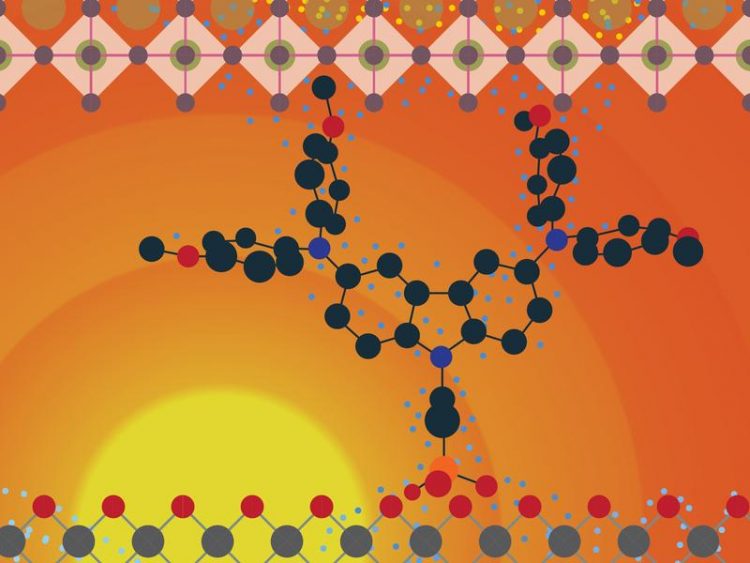Molecules that self-assemble into monolayers for efficient perovskite solar cells

The molecule organises itself on the electrode surface until a dense, uniform monolayer is formed. HZB/Saule Magomedoviene
In recent years, solar cells based on metal halide perovskites have achieved an exceptional increase in efficiency.
These materials promise cost-effective and flexible solar cells, and can be combined with conventional PV materials such as silicon to form particularly efficient tandem solar cells.
An important step towards mass production is the development of efficient electrical contact layers that would allow deposition of perovskite layers on various substrates.
Molecules form monolayer
Now the HZB Young Investigator Group headed by physicist Dr. Steve Albrecht, in collaboration with former DAAD exchange student Artiom Magomedov from Kaunas University of Technology (KTU) in Lithuania, has synthesized a novel molecule that self-assembles into a monolayer (SAM).
The team successfully used this new material as a hole-conducting layer in perovskite solar cells. The molecule is carbazole-based and bonds to the oxide of the transparent electrode via a phosphonic acid anchoring group.
Due to the anchoring fragment, this molecule organises itself on the electrode surface until a dense, uniform monolayer is formed.
The ultra-thin layer exhibits no optical losses and, thanks to its self-organising property, could conformally cover any surface – including textured silicon in tandem solar-cell architectures.
Adaption possible
Extremely low material consumption is achieved with this technique, and the chemical structure of the SAMs can be adapted to the desired application. Thus, SAMs could also serve as a model system for future investigations of the properties of perovskite interfaces and growth.
New generation to be developed at HySPRINT Lab
The work took place at the HySPRINT laboratory of the HZB where Albrecht's group is now conducting research on a new generation of self-assembling molecules, which already enable solar cells with efficiencies of over 21 %.
Patent application filed
Since this approach to perovskite solar cells has never been considered before and can potentially play a role in industrial processes, the HZB and KTU teams have filed a patent application on the molecule and its use.
As the scientific interest for this new contact material class is enormous, the journal has displayed an illustration from the paper on the front cover of the current issue.
Published in Advanced Energy Materials 2018: “Self‐Assembled Hole Transporting Monolayer for Highly Efficient Perovskite Solar Cells”. Artiom Magomedov, Amran Al‐Ashouri, Ernestas Kasparavičius, Simona Strazdaite, Gediminas Niaura, Marko Jošt, Tadas Malinauskas, Steve Albrecht and Vytautas Getautis.
Doi: 10.1002/aenm.201870139
Autor: Amran Al Ashouri, PhD student and shared first author of the publication
Amran Al-Ashouri
E-Mail: amran.al-ashouri@helmholtz-berlin.de
Dr. Steve Albrecht
E-Mail: steve.albrecht@helmholtz-berlin.de
10.1002/aenm.201870139
http://dx.doi.org/10.1002/aenm.201870139
http://www.helmholtz-berlin.de/pubbin/news_seite?nid=20207;sprache=en;seitenid=1
Media Contact
All latest news from the category: Life Sciences and Chemistry
Articles and reports from the Life Sciences and chemistry area deal with applied and basic research into modern biology, chemistry and human medicine.
Valuable information can be found on a range of life sciences fields including bacteriology, biochemistry, bionics, bioinformatics, biophysics, biotechnology, genetics, geobotany, human biology, marine biology, microbiology, molecular biology, cellular biology, zoology, bioinorganic chemistry, microchemistry and environmental chemistry.
Newest articles

First-of-its-kind study uses remote sensing to monitor plastic debris in rivers and lakes
Remote sensing creates a cost-effective solution to monitoring plastic pollution. A first-of-its-kind study from researchers at the University of Minnesota Twin Cities shows how remote sensing can help monitor and…

Laser-based artificial neuron mimics nerve cell functions at lightning speed
With a processing speed a billion times faster than nature, chip-based laser neuron could help advance AI tasks such as pattern recognition and sequence prediction. Researchers have developed a laser-based…

Optimising the processing of plastic waste
Just one look in the yellow bin reveals a colourful jumble of different types of plastic. However, the purer and more uniform plastic waste is, the easier it is to…



